Brenda Knight Graham's Blog, page 5
July 30, 2024
Threading a Needle
Our doctors these days add an age P.S. to every diagnosis: “You know, when you’re in your eighties you can’t expect to do the same things you used to.” Well, actually, we do expect to, but our expectations are dashed often. For instance, yesterday I needed to thread a needle.
I was trying to do a very simple hemming job, no big deal. I talked to the sewing machine. “I know I haven’t used you for a while but I need you to run perfectly.” Well, I’d barely begun when the thread broke.
I studied the tangle problem and even fixed it, so glad I’d remembered at least one trick my machine liked to play. But the needle still needed threading. I took a deep breath and tried to focus on that tiny hole. My goodness! Was it even there? The needle was so fine I could hardly see it, much less the miniscule eye. The thread looked more like a rope, maybe a limber jump rope. Even when I could get the tiny eye in focus my shaky fingers sent the rope everywhere but through.
It was impossible, as impossible as–well, finding a needle in a haystack.
I reined in my impatient nerves and said, “Now, sweet sewing machine, you know we have to do this. We’ve always done this. We still can.” I bravely began again, trying to see the eye and control my shaky fingers. Occasionally, by twisting this way and that, I thought I could see the tiny eye well enough but the thread refused to feed through.
Finally, I spoke to the Lord instead of the sewing machine. “Please help me do this simple job, Lord.”
After a few more tries I suddenly realized the thread had gone through the eye and I was about to pull it out in my frustration. I sat back and laughed, breathed deeply, and began sewing. There were no more mishaps. That’s the first time in my life that I’ve realized God threaded a needle for me.
Of course age does add wisdom, doesn’t it, at least sometimes? Maybe I just never noticed before that God was threading my needle!
Even to your old age and gray hairs I am he, I am he who will sustain you. I have made you and I will carry you; I will sustain you and I will rescue you. Isaiah 46:4 (NIV)
July 22, 2024
Tulip Hill
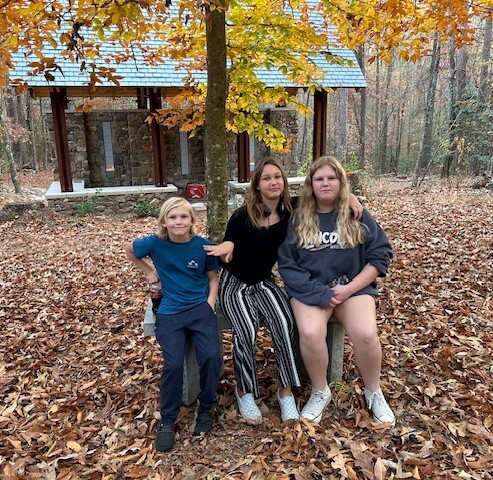
In the summertime at Pinedale, my sister Suzanne and I played on Tulip Hill while two of our brothers, Stanley and Charlie, milked the cows. We named a favorite oak tree “the Sunset Tree” because it was often sunset when we climbed it. At other times, too, we played on Tulip Hill, making dancing girls of the tulip tree blossoms in springtime, exploring the woods and a deep gully we dubbed Grand Canyon, and hunting birds’ nests.
Until 1959 when my dad died, Tulip Hill had only been a happy place. Dad chose to be buried on Tulip Hill because he wanted to be buried on a hill and because it would require less tree cutting to start a new cemetery than to increase the size of the old one. The original Knight family cemetery is a ferny place in a valley. The small graveyard is surrounded by a dry wall and great tall pines. My grandfather must not have considered there would be so many more graves.
So Tulip Hill was no longer a place of pure happiness. Eventually, a cemetery committee was formed, a road was extended to the back side of the hill, the Sunset Tree died and had to be cut along with others.
Though there is a deep joy when we say goodby to family members whose destination is heaven, there are so many tears too, so much sorrow. It is always good to see so many relatives and friends at those sad times. But it is sad too! Time and again our family has climbed Tulip Hill to say last goodbys to sisters, brothers, nephews and nieces, and even some of our own children.
My nephew, Joe, and his wife, Lourdes, both architects, have built a beautiful little stone chapel at the edge of the cemetery. In keeping with the family home, Stone Gables, which is on the next hill, the chapel is constructed largely of mountain flint stone. With an open view of the cemetery, a wall inside is devoted to niches in which cremation urns may be placed. Joe’s older brother, Tom, the oldest of that generation, was the first to be placed there.
Now there is a solemnity about Tulip Hill that was never there in the old days. When one arrives at the top of the hill, there’s a hush similar to the quietness in a church. But a few months ago I saw some of that innocent jubilance restored to the hill.
My grandson Charles D and I, during an annual family reunion, were showing three of my great grandchildren, his nieces and nephews, around Pinedale. When we arrived at the cemetery the children–Caitlin, Charli, and Kaison–began to dance and flit amongst the gravestones, not irreverently, just having fun. One said “Who is this?” referring to a grave and then another asked “And who’s that?”
I began telling them about family members so dear to me, unknown to them. Here was Pat, our oldest sister, who was a second mama always watching out for all of us. Nearby was Orman, my oldest brother who was Habersham County’s first Eagle Scout and went on to be a missionary in the Philippines. And there were the graves of the children’s great great grandparents, my parents, F.S. and Eula Knight who had eleven children and who established this wonderful wildlife sanctuary called Pinedale.
I told them about Ginger who loved collecting dolls after she retired from mission work. I told them about Stanley and John and Jonathan. And they sat on the bench honoring their Gammy, my daughter Julie.
Not always prone to listen to Nana for very long, the children paid close attention that day. As I described different ones it seemed as if they were alive again–Stanley playing his harmonica, Orman telling one of his gripping stories, and Grandmother Eula saying quietly and proudly, “Look what Dad and I started!” Charles D added his own memories of many buried there.
Instead of being a solemn group leaving the little cemetery, we were laughing and spinning tales. Charli even did one of her amazing backbends right beside Gammy’s bench.
Tulip Hill is a place of fond memories from long ago, bittersweet gatherings around open graves, and also bright young voices claiming the joy of the present.
July 8, 2024
Sam’s Turtle
He was a flop-eared, gangly, bright-coated dog, our Irish setter named Sam. He was a rescue dog who loved unconditionally and literally chased after life. He was my walking companion for several years. It was before leash laws in Cairo so Sam was free to investigate every scent along our three-mile morning walk, to swim the ponds, and stop for a talk with a turtle.
But one morning sniffing a turtle he discovered in our neighbor’s yard was not enough. He mouthed it, turned it over a time or two, then stood back watching for the turtle’s reaction, then nosed it again. When I called him to come along, he looked at me, then back at the turtle, obviously torn between eagerness and obedience.
Next thing I knew, Sam picked up the turtle in his mouth and ran on ahead of me. I laughed and tried to retrieve the turtle, but Sam would have none of it. He loped along our familiar route, his grin greatly deformed by his passenger.
He couldn’t swim the ponds that morning. He couldn’t sniff every little trail. He couldn’t bark at a squirrel or at the little friendly cocker spaniel we passed. I kept thinking he would put the turtle down somewhere along the way but, no, Sam had taken responsibility for this hard shelled friend and he would not give it up.
All the way around Oakdale Circle we went, past the Davids’ house and the street where the Hueys and the Hinsons lived, back to the little lake sparkling in morning sunshine. I thought that might be a good place for Sam to leave the turtle, there on the dam. Sam did not agree with me.
We arrived back on our street and I realized Sam must be taking his new friend home with him. But Sam was more thoughtful than that. His passenger was a friend, not a prisoner. He very deliberately, with fluffy red tail wagging, entered our neighbor’s yard and carefully deposited his passenger by the shrub where he’d found him. Looking back only once, he loped home ahead of me.
I watched the turtle a moment as he gradually became acclimated and scuttled under the camellia bush. What in the world would it be like to be a turtle minding your own simple business and suddenly to be picked up bodily by a great slobbery thing and hauled off to who knows where? And then, wonder of wonders, to find yourself sound and free in your own familiar surroundings?
That turtle definitely had one gripping story to tell his grandchildren! I hope he told them what a gentle giant Sam was. Even the worst scenario can turn out good in the end.
June 29, 2024
Blueberry Season
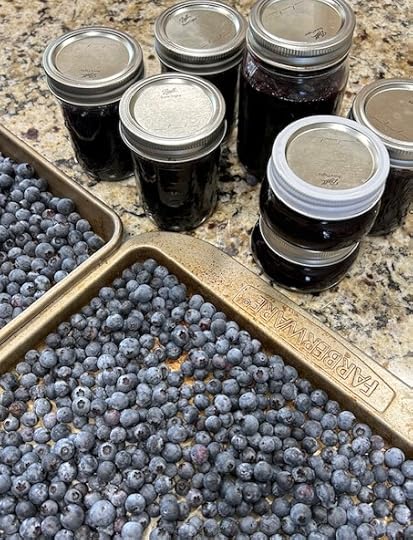
Today the berries were not as plentiful as before and not as plump and juicy. The mockingbird that usually fusses loudly as we pick was nowhere around, even though Bertha the cat lay boldly grooming herself beneath a barren bush. I haven’t been sure whether the mockingbird was angry at us for picking his berries, or angry at Bertha just for being a cat. It seems maybe he/she was most upset with us for stealing his berries, though there were plenty for all of us.
We’ve been picking several times a week since mid-May. We’ve been able to share with friends, make cobblers, muffins, and two batches of jam, and still store about thirty-five quarts in the freezer. That’s not counting eating them on cereal every morning and snacking on them freely.
For two folks in their eighties, one with leukemia/lymphoma and the other hobbling with a walker, we have a great number of blessings for which to be thankful. The blueberries, for instance, have been a delight in many ways.
We’re thankful for the eight blueberry bushes planted and carefully cultivated by Charles when his health was robust. Now they are rewarding him for his husbandry. In times past, at the old house with other bushes, I was happy if I could pick enough berries for a pie. Now, always, we have to leave some for the mockingbirds. Charles usually picks a half gallon to my quart or so but I’m thrilled to be able to squeeze my walker into the thick of the harvest and pick until I can’t.
I asked Charles if he had tips for other homeowners growing blueberries in their yard. He gave me the following: 1) Plant at least two varieties. Pollination will be better and you may extend your production season by having berries ripen at different times. 2) Bushes will not bear a significant number of berries for about three years. 3) You may need to test the soil for acidity. You can take a small sample to your county agent. 4)The agent may tell you more acidity or less is needed. You can add more with your fertilizer. 5) During dry seasons, water the bushes, especially in first year or two. 6) You can choose varieties whose leaves turn red in the fall–a beautiful extra!
We’re thankful for the very beauty of the blueberries, both on the branches, in our buckets, and bubbling in a peach berry cobbler. I love the sound of berries hitting the bottoms of our buckets, but I like even better the absence of the pings as our buckets fill. I love the aroma of streusel blueberry muffins baking and the sheer joy of baking with a granddaughter.
I’m ever so thankful to God that in many ways Charles is better now than he was for blueberry season last year. We made the jam together, processing the berries in the blender, filling hot jars, and finally sitting back, tired and joyful, listening to the pops of the lids sealing.
Yes, we enjoyed blueberry season, but now that it’s waning, I think we may be thankful not to hustle in the bushes so much. Maybe we can sit back and enjoy the sweet songs of the mockingbirds.
Do not be anxious about anything, but in every situation, by prayer and petition with thanksgiving, present your requests to God. Philippians 4:6
June 20, 2024
Picas of Lassen Mountain
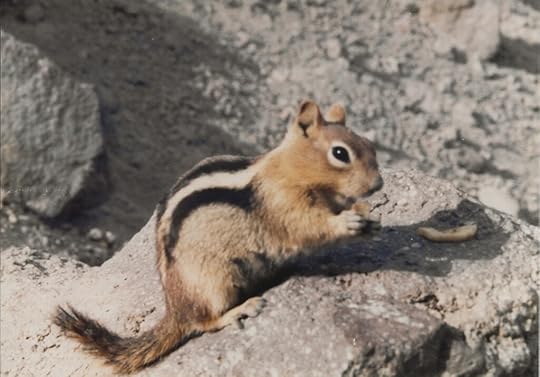
A pica on Lassen Mountain eating banana chips
On our spontaneous hike up a volcanic mountain in north California we enjoyed, among many things, watching tiny chipmunk-like picas nimbly navigating stark rocks beside our narrow trail. On our trip from Cairo, Georgia to Portland, Oregon by way of Niagara Falls and Guelph, Ontario (tent in trunk of our old Buick) we saw many chipmunks or picas, none quite as friendly as these. Now we were on our way home, taking in the sights of western USA. We saw a sign to Mt. Lassen, drove up to the parking lot, and decided to take the hike up to the crater of this quiet (hadn’t erupted since 1914) volcanic mountain.
We were struck by the absence of life on the mountain. The only living, breathing creatures we saw were the cute little striped picas.
We paused to catch our breath and munch on dried banana chips. The picas joined us, fearless and eager for a treat. They didn’t mind at all having a photo shoot. Their tiny sleek bodies were well fleshed. What did they eat on this barren mountain? The only vegetation we saw that day in July were scrubby pines and a delicate flowering plant growing in rock crevices. We saw no berries, nuts, or succulent sprouts.
Maybe there were worms, tiny lizards, insects the picas could find. Maybe there was some kind of mushroom we didn’t notice, or maybe they could eat the crunchy looking lichen growing sparingly on certain rocks.
There were very few hikers on the trail that day so the picas couldn’t depend on treats every day. But obviously they were cared for. There was something, even along the icy trail, to sustain them.
I was reminded that picas are equipped to survive where they are, just as are the iguanas in the desert, the penguins in Antarctica, the gazelles in Africa.
Years later, now, when we visit our son and his family in Mountain Brook, Alabama, we’re amused by the swiftly running striped chipmunks in their yard. The fact that they are pests, digging holes everywhere, doesn’t keep me from admiring their spunk. They have an easy life compared to their cousins on Lassen Mountain, but still a challenging one. They have to hide from swooping owls, cats, and, above all, my son, the sharpshooter with the pellet gun.
June 14, 2024
My Dad’s First Flight
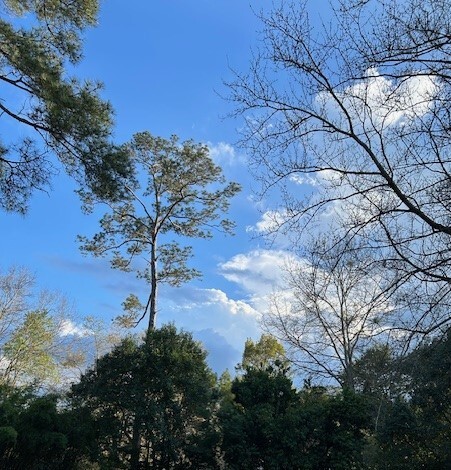
My dad had never flown before. He had done many things but he had never taken to the sky, except in painting beautiful sky pictures. My dad turned fourteen in 1900 when transportation was by horse and buggy. He owned his first vehicle, an Edsel truck, I believe, about 1910. He homesteaded on Cape Canaveral for several years, studied at Chicago Art Institute, wrote for the Atlanta Journal, and was a popular artist in Atlanta. All that before he married at age thirty-six. He and Mamma (who was only eighteen when they married) had eleven children. They built an English manor-style stone house in Habersham County, Georgia, on family property to which Daddy added more acres as he could.
But in 1950, at age 64, my dad had never flown.
My oldest brother, Orman, lived in Chicago then and wanted my dad to fly up for a visit. He and Mamma had long conversations and it was decided he would go. It was an awesome thing–my dad going on any trip without some of us. But by airplane? After all, he wasn’t the only one who hadn’t flown. Neither had any of us, except John who’d been stationed in post-war Japan. It was John who took Daddy to the Atlanta airport. We saw him off from our front steps. The slightest smile twitched below his gray mustache (carefully trimmed by Mamma) as he tipped his Sunday hat to us.
The house was amazingly quiet with Daddy gone. Nobody turned on the radio to hear H.V.Kaltenborn’s nightly news or Paul Harvey’s news and comments at noon. Mamma and Daddy homeschooled all of us, but that week we didn’t hear his deep voice expounding on current affairs, teaching history, or making comments on the literature we read each evening. And we didn’t hear his wonderful stories like the one about how his father was pronounced dead at two years old on a ship from England to Canada. Obviously, his father revived from the deep coma he was in!
When Daddy came home he had more stories to tell. He told about riding the El in Chicago as far as it went and back. He spent hours at the Art Institute and, of course, spent time with my brother and his family. He said the city had changed so much it was hard to recognize. But my favorite recollection was that of his actual flight.
I couldn’t imagine my dad being anxious or afraid of anything. So when he told us he sang hymns on the plane to calm his nerves I was truly awed. He said he thought the roar of the plane would keep other passengers from noticing his singing. But we knew from our family worship times how forcefully Daddy sang and we were sure the passengers had clearly heard him singing “The Haven of Rest.”
My dad was a bigger-than-life man. Somehow, his telling this account, of his anxiety and how he handled it, made me as a little girl respect him even more. Some things my dad did I’ve tried to follow. But never have I sung a hymn on a flight. However, I have remembered, during anxious times, to rely on God’s haven of rest.
I’ve anchored my soul in the haven of rest, I’ll sail the wide seas no more. Though tempests may sweep o’er the wild stormy deep; In Jesus I’m safe evermore.–Henry Lake Gilmore
HAPPY FATHER’S DAY TO ALL FATHERS!
June 6, 2024
The Real Thing
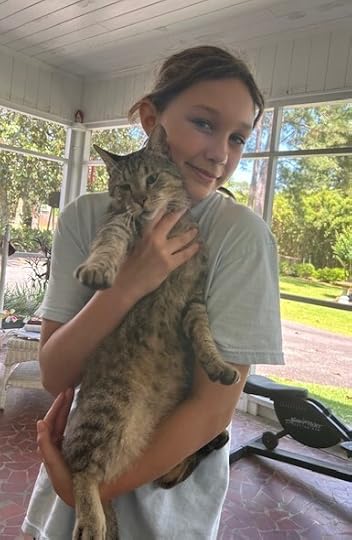
I noticed Dinji, our one-eyed gray cat, sitting at the foot of our “See Rock City” bird house. His body was tense, ready to spring, eying something above him. I couldn’t see anything he could be so interested in. All day, from time to time, he was right there intensely watching, his body in hunting mode. I wondered what he saw. A bird I hadn’t noticed? A lizard? I could see no movement around that bird house pole. Off and on, he took up his post, all but licking his chops. Even the next day, there he was, watching and waiting.
After two days he finally gave up. Puzzled, I speculated about what he’d thought he could catch. Then it became obvious. There is a decorative red cardinal atop the “See Rock City” bird house. Apparently, Dinji thought that bird, the right color and size but immovable, was a real bird.
Poor Dinji! He thought he saw a real bird and waited so patiently for it to fly down where he could snatch it out of the air. But it never moved.
As we send congratulation cards to high school graduates I’m reminded to pray they will be able to recognize the real thing, Jesus and His teachings, and not be swayed or confused by all the attractive false ideas. At colleges, jobs, wherever they go, they will encounter so many beautiful “birds” perched realistically and so temptingly. But those will never satisfy the hungry heart.
All that thrills my soul is Jesus, He is more than life to me; And the fairest of ten thousand In my blessed Lord I see. —Thoro Harris, 1931
May 30, 2024
Stars and Stripes
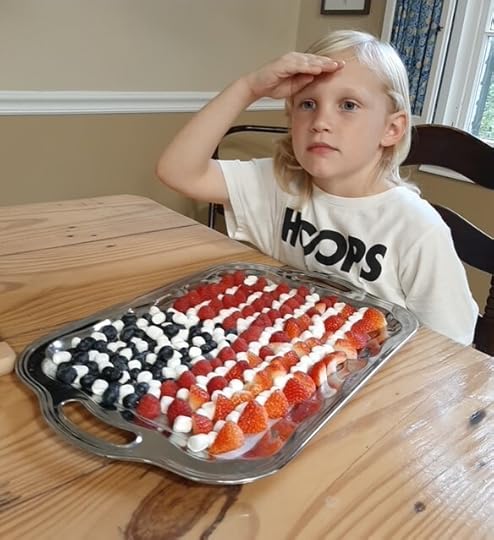
One of my favorite United States of America flag memories, and there are many, is that of our great grandson Kaison Evans at eight years old saluting a berry flag he and I made.
Looking at this picture reminds me of the fun we had that day making the sweet flag. Of course we ate some of the berries and baby marshmallows as we constructed the stars and stripes. But the best part of the whole experience, to me, was the sight of Kaison voluntarily saluting that flag in all seriousness. Saluting the flag wasn’t enough. He jumped up, scrolled quickly on his phone to a flag with National Anthem playing and, there in our kitchen, we sang and saluted with earnestness and volume. Another time, with no berry flag to salute, Kaison instigated a flag ceremony including Granddaddy as we stood solemnly in our breakfast room singing lustily with cell phone accompaniment, “Oh, say can you see….”
It was always a thrill to stand and salute the flag as the Cairo High School Syrupmaker Band played the National Anthem before a Friday night football game. Our hearts beat with pride as our son, Will Graham, played the flugabone (baritone). Later, our granddaughter, Amanda Evans, played clarinet in the band. Will went on to play trombone in UGA’s Dixie Redcoat Band. You can imagine our emotion as we sought out our own boy in that huge stadium and saluted the flag as the band played. I loved it, too, when the band played John Philip Sousa’s “Stars and Stripes Forever.” Also, our grandson Charles Reeves made us proud marching smartly down the football field in the color guard of the NJROTC at a Friday night game.
This Memorial Day/Flag Day week, thanks to Jesse Hobby and other faithful and passionate veterans, flags are unfurled all along both sides of North Broad Street in our little town, Cairo, Georgia. Each flag stands for a veteran who gave the ultimate sacrifice in one of several wars–Korean, Vietnamese, and both world wars. I loved it when Charles and I, other years, could walk the street and stop by each flag, reading the veteran’s name and noting in which conflict he served. Still, we can drive by and thank God for these who gave themselves, some hardly more than children at the time, so we may enjoy precious freedoms.
Our own American flag, high on its pole by our front steps, flips and snaps in a good breeze outside my window as I type. A quick shadow of it caresses the floor. How I love that flag! Not just that particular flag (purchased by us during a historic visit to Washington, DC) but all American flags, displayed at courthouses, town squares, football stadiums, and draped on coffins of fallen heroes. The flag stands for the right to sing “God Bless America”; it stands for our freedom to be individuals of widely differing opinions; it stands for our right to work hard, to succeed, to raise children to love the Lord, to be safe and secure, to enjoy dependable governmental representation. The flag stands for, yes, our right to fly this flag high and sing the National Anthem with pride and enthusiasm at football games, at other public gatherings and–in our own breakfast room!
“You’re a grand old flag. You’re a high flying flag. And forever in peace may you wave. You’re the emblem of The land I love, The home of the free and the brave…” –George M. Cohan
May 23, 2024
Keep Looking Up
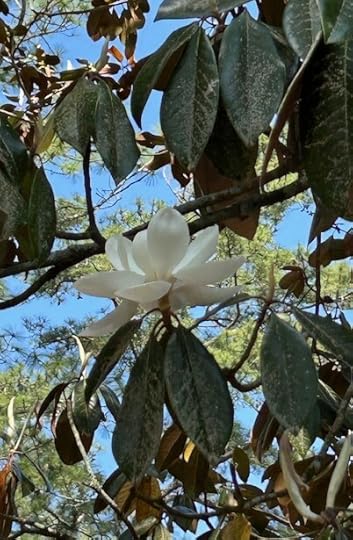
I would have missed this wonderful magnolia blossom if I hadn’t looked up. Day lilies of gold and burgundy, blue and oak hydrangea, Nile lilies the color of the sky, and a red firecracker plant displaying its brand new explosive blooms just in time for Memorial Day–these I can easily see as I walk. But to see the magnolia blossoms I have to look up, sometimes way up.
The blossom reminds me of an elegant porcelain chandelier, especially with sunlight sifting in. Other blooms high in the trees make me think of brides awaiting their magical moment. I think, too, of “Steel Magnolias,” the Dolly Parton movie in which beautiful women show what they’re made of when tragedy hits.
What else would I miss if I didn’t look up?
I’d miss amazing sky scapes. Sometimes the sky is so beautiful I can only say, “Thank you, thank you, Lord.” Whether drifting, feathery clouds changing by the minute, or a wide-open expanse of deep blue, or a sunset-stained sky, or one pricked with stars, all are incredibly marvelous. And all that, not to even mention the moon as a thin sliver or as a full fat disc.
What about birds’ nests? Yesterday I looked up to see a pair of birds–mockingbirds, I think–flying in and out of a thick jasmine vine climbing our mailbox pine. I saw bits of debris in their beaks and knew it was nest building time for them. More than once I have observed mourning doves building a sprangly nest on the flat of a wide palm branch. Better than that view was the one of babies walking up and down that branch before they flew. It was as if the branch were their neighborhood playground.
Though I do love a quiet sky, I am also fascinated with planes, high flying jets, small planes from our own Grady County airport, and an occasional helicopter. Sometimes I wouldn’t know a jet was flying over unless I looked up to see the stream of vapor behind it making weird streaks in the sky.
Without looking up I’d miss the breezes playing in the tops of pine and oak. I’d miss the orange and red trumpet flowers on the trellis at the library. And I’d miss the purple wisteria climbing amongst the reeds, lush as Caleb and Joshua’s grape clusters.
An old pastor of my home church was often quoted in our family when things turned a bit dismal. Someone would say, “As Pastor White says, ‘Keep looking up.'” Pastor White wasn’t talking about magnolia blossoms, birds’ nests, high flying planes or wisteria vines. He was talking about our walk with Jesus. He was talking about our trusting Him when life is dark. He was talking about keeping our eyes (our consciousness, our focus) on Jesus rather than on frustrating circumstances down on our level.
If life is throwing you a curve, if you find yourself in a rut, if trouble is hounding you–don’t forget: “Keep looking up.”
For in the day of trouble he will keep me safe in his dwelling; he will hide me in the shelter of his sacred tent and set me high upon a rock. Psalm 27:5
May 18, 2024
Searching for Eagles
There were six of us on that trip down an Alaskan river. We left the cruise ship in gathering excitement as we went to view wildlife in the wilderness. Many eagles might be seen on this day trip we were told. On other shore trips we split up choosing various jaunts: viewing Mendenhall Glacier, riding a cable car up a mountain to see Juneau from above, trekking a rain forest and more. But we’d chosen to go together on this excursion to see Alaskan wildlife up close.
We were all over sixty except my niece who was an avid wildlife enthusiast and was particularly looking forward to seeing eagles. She is a very compassionate and thorough advocate for the needy, a busy social worker by profession. Others of us were a chemist, a day care director, an English professor, a veterinarian and yours truly, all family.
Even in July, it was cold when we left the bus and walked to the dock. We were glad for the ponchos we were given and somewhat dubious about the life jackets. Did we really need these? We joked and teased each other as we settled in the boat.
The water looked like what my mother called bluejohn, weak fat-free milk. The guide explained it was glacier water and added that the river was very shallow and that there were many sand bars. He assured us he knew how to navigate around them though they weren’t visible in the milky water. He then began to describe what we would see as we went down the river.
We would see elk and moose, maybe a bear–and eagles. “Look into the treetops,” he said. “There are many eagles in Alaska, and this is one of the best places to see them in their natural habitat.”
My niece had binoculars. She scanned the treetops. We all looked eagerly for the sight of a big-eared moose or an elk with mighty antlers. Every little movement on the shore, a tree branch shifting or a wave lapping, caused an intake of breath. Was that….? But no, it wasn’t.
The guide repeatedly urged us to look at the treetops, study the foliage by the stream. We would see wildlife, he assured us. The group before us had seen three eagles, a moose, and even a bear. Our chemist suggested that maybe the group before us had scared the animals away. We all laughed and the guide admonished us saying we might ourselves be scaring them away.
Our veterinarian began plying the guide with questions about the habits of the animals. Did they usually come out earlier in the morning? Were they not intimidated by the air boat of strangers?
My niece squealed that she’d spied an eagle’s nest. But there was no eagle in sight. The guide maneuvered around yet another sand bar and said, with what I thought was a shade of panic, that we would certainly see some wildlife around the next curve.
There were more eagles’ nests. But no eagles. I decided seeing a huge sprangly nest high in a wind scarred tree was really pretty wonderful. Our English professor began to quote Emily Dickinson: “Hope is the thing with feathers…” Our day care director commented that probably the mothers were all with their babies for a much-needed nap.
We came to the bend where we were to turn around. The guide said, trying to sound positive, “We’ll see something on the way back.”
We did see something. We saw the gray, lowering sky, the milky quiet river, and the same eagles’ nests we’d seen before, none of which seemed occupied. We arrived back at the dock, six disappointed explorers.
Steaming mugs of hot chocolate, jovial hostesses, and an adventurous camaraderie amongst our six helped assuage our disappointment. The chemist and the veterinarian asked enough questions of the hostesses to fill a book. When the bus came for us, we were jabbering as if we’d seen at least six eagles, all of us except our eagle-seeking niece, that is.
Back at the ship, after a lovely dinner, our niece excused herself to go walk the decks as she always did. She didn’t mind the cold wind and was intent on seeing as much as she could on this once-in-a-lifetime trip. She returned to us literally bouncing with excitement. As she stood at the prow of the ship, she said, an eagle lit only thirty or so feet from her and perched there for several minutes. As it was, she saw many more eagles on other excursions, but that one was most memorable.
We all searched but only the one most persistent actually saw an eagle that day.
You will seek me and find me when you seek me with all your heart. Jeremiah 29:13
Brenda Knight Graham's Blog
- Brenda Knight Graham's profile
- 1 follower



